Abstract
1. The lowest water temperature in which different young adults could stabilize body temperature was found to vary from 32 degrees C to less than 12 degrees C, because of large differences in both total body insulation and metabolic heat production. 2. Total body insulation per unit surface area, in the coldest water allowing stability, was quite closely determined by mean subcutaneous fat thickness measured ultrasonically (r = 0.92), regardless of differences in distribution of this fat between men and women. 3. Reactive individuals developed high metabolic rates, and often rather high insulations in relation to fat thickness, which enabled them to stabilize their body temperatures in water more than 10 degrees C colder than was possible for less reactive individuals of similar fat thickness. 4. Measurements of heat flux, after stabilization in the coldest water possible, showed that the trunk was the main site of heat loss and that over half of the internal insulation there could be accounted for by subcutaneous fat; by contrast, fat could account for less than a third of higher insulations found in muscular parts of the limbs, and for less than 3% of very high insulations in the hands and feet. 5. After stabilization of body temperature at rest in the coldest possible water, exercise reduced internal insulation only in muscular parts of the limbs. Exercise also increased heat loss elsewhere by exposing skin of protected regions such as flexural surfaces of joints. During exercise total heat production increased rather more than heat loss in unreactive subjects, but less than loss in subjects whose heat production had already risen to a high level when they were at rest in cold water. 6. In warm (37 degrees C) water, tissue insulations were lower and much more uniform between subjects and between different body regions than in the cold. Even in the warm, however, insulations remained rather higher in fat than thin subjects, higher at rest than during exercise, and usually higher in the limbs than the upper trunk.
Full text
PDF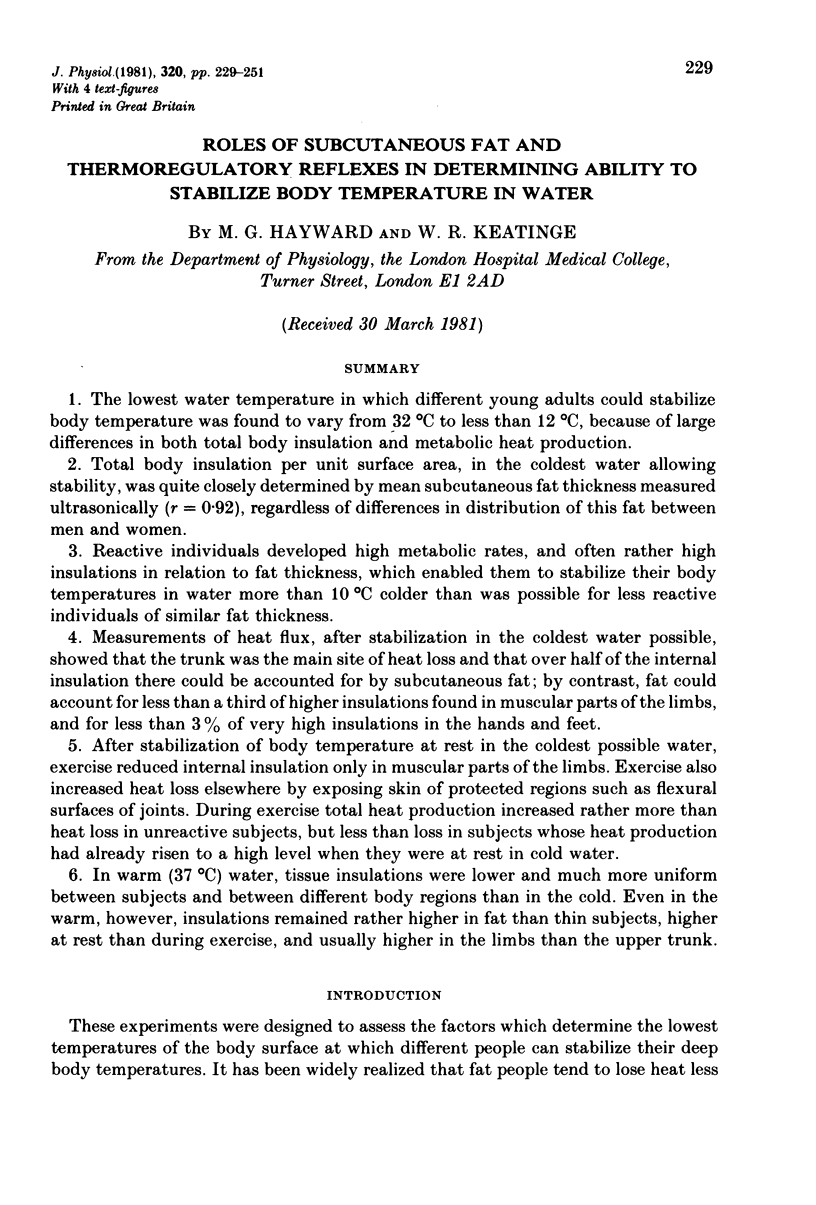
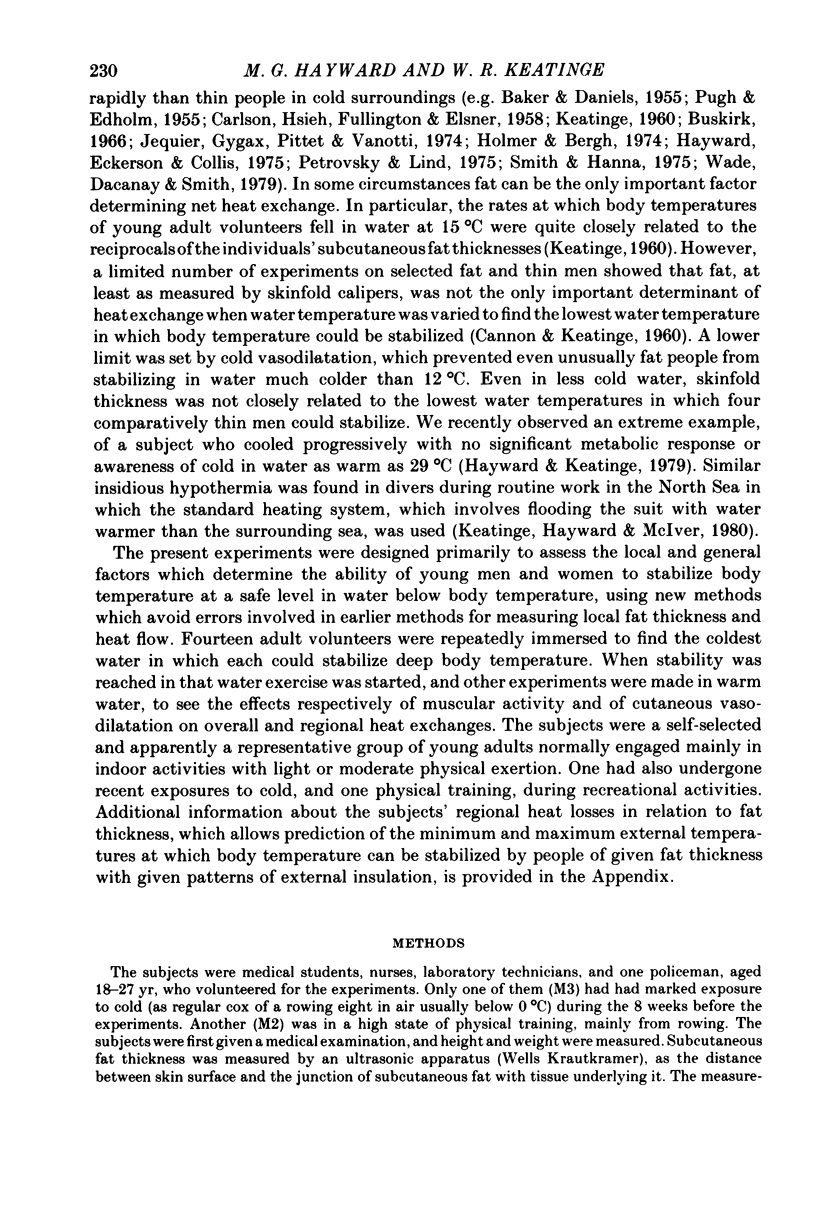
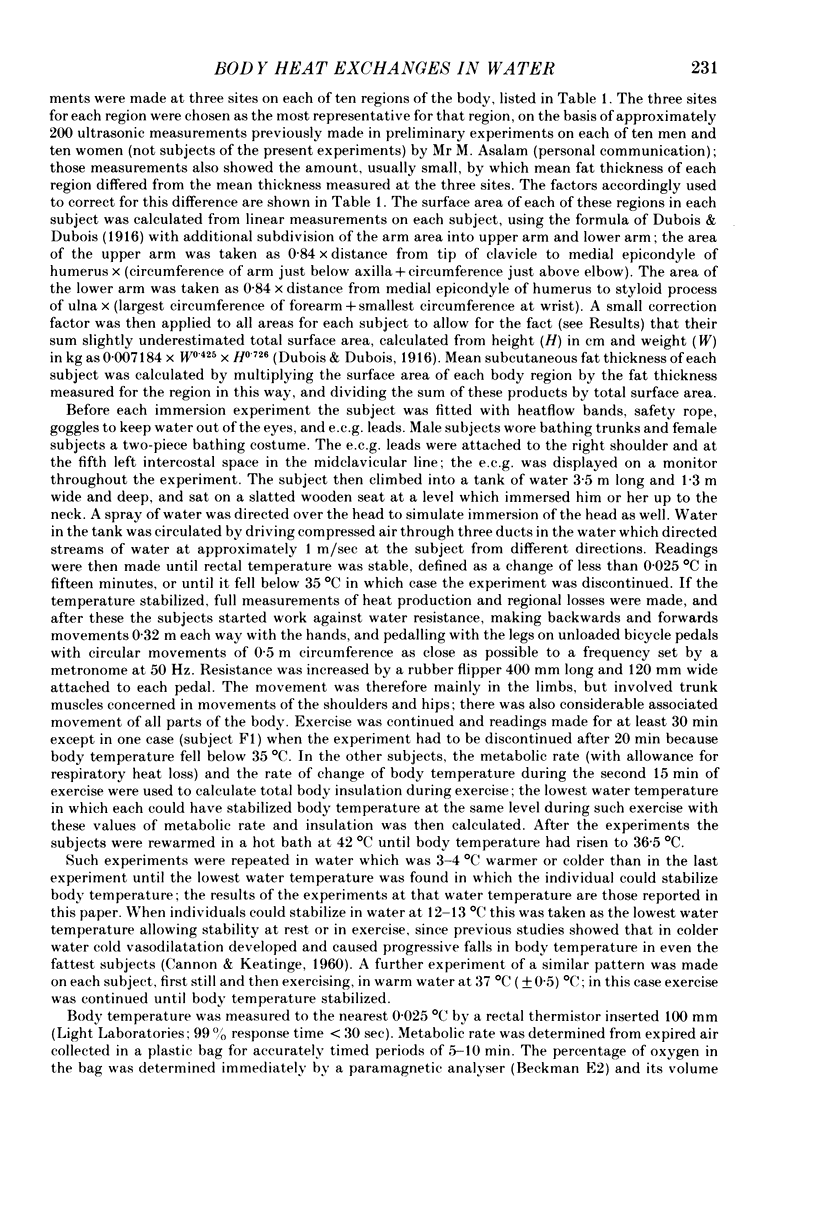
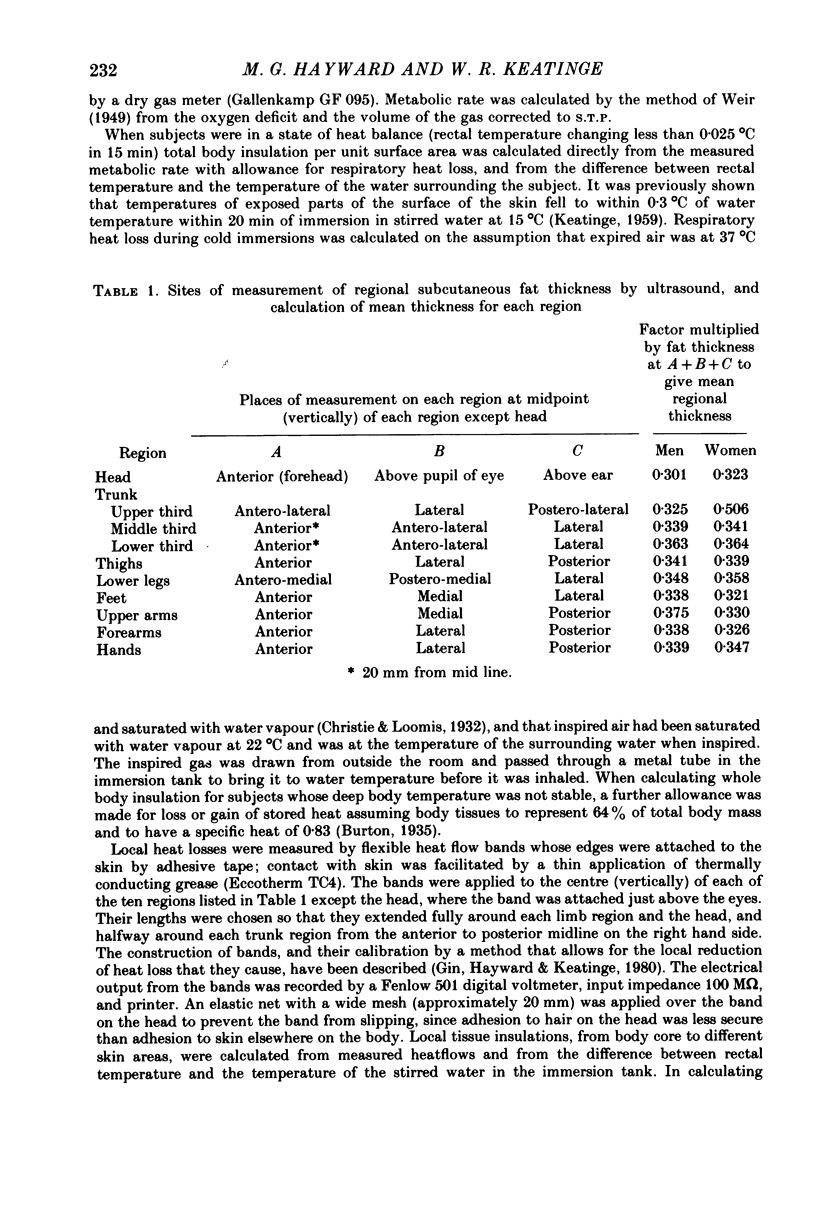
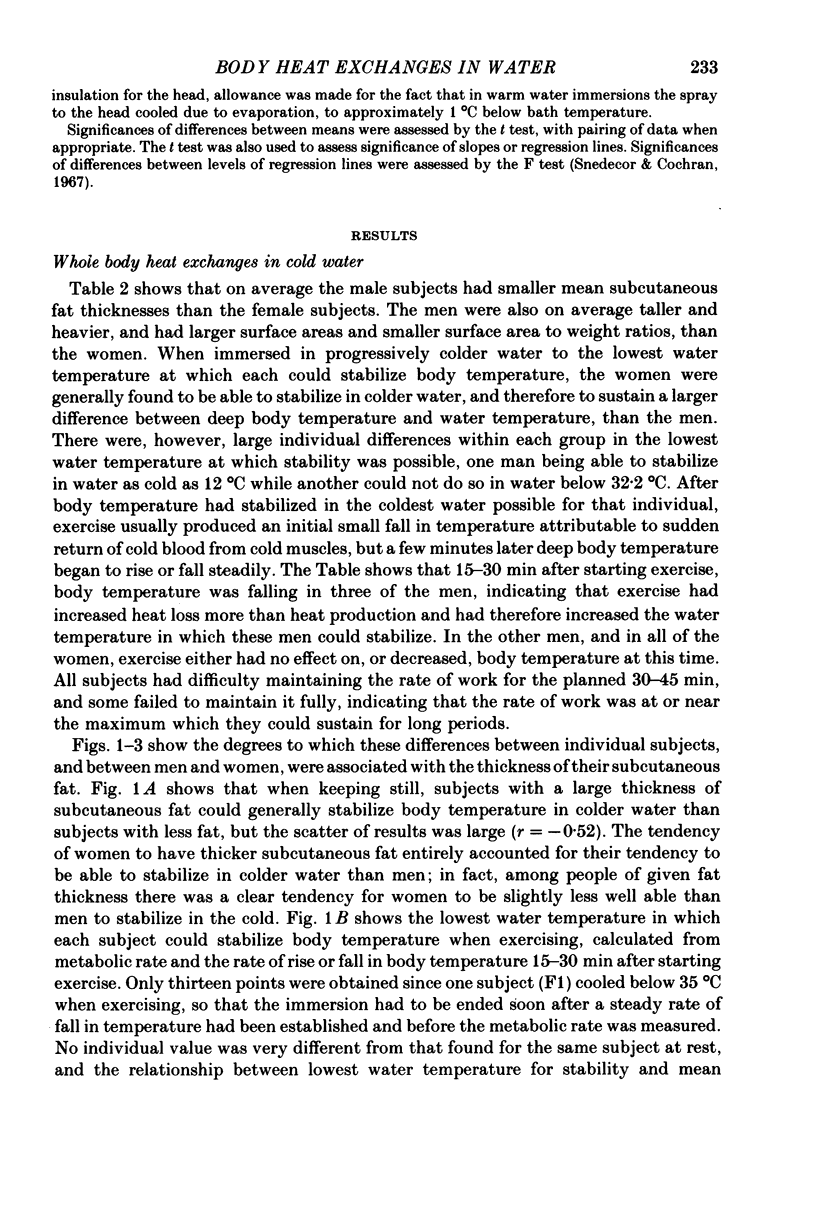
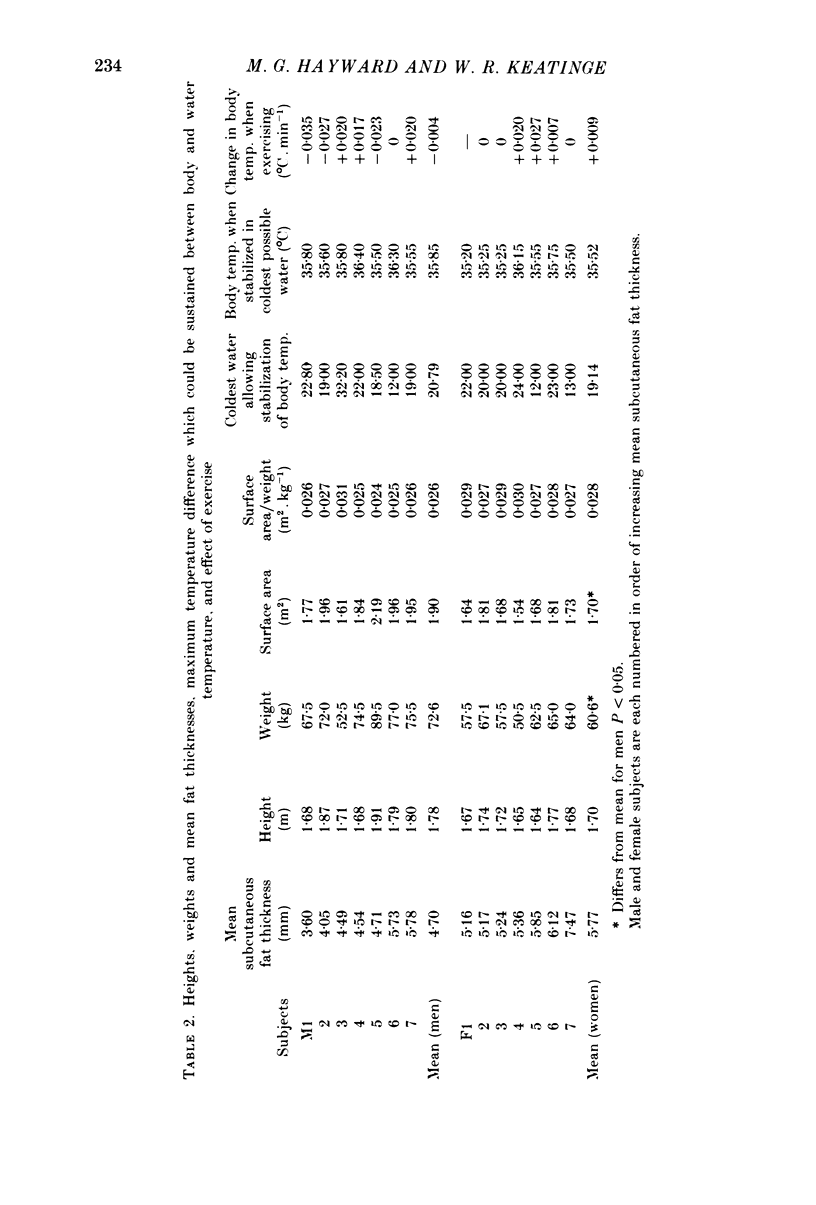
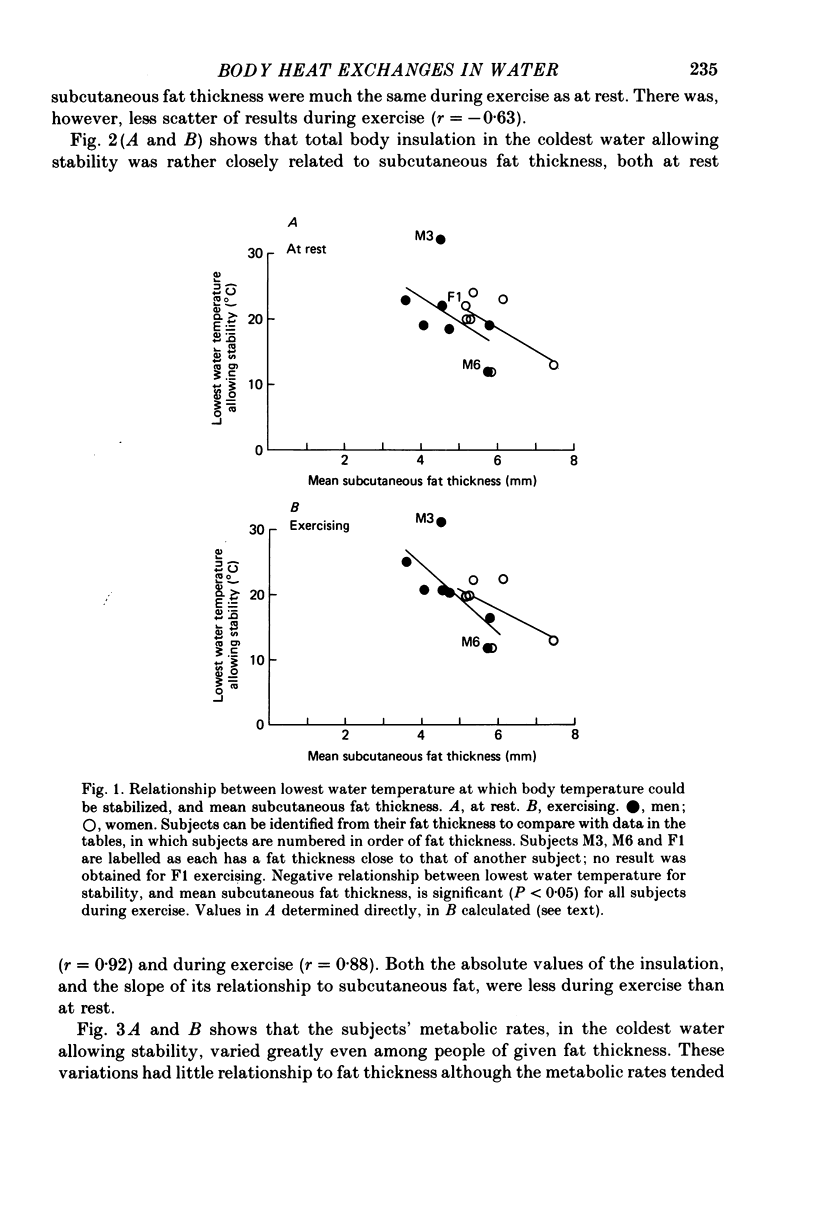
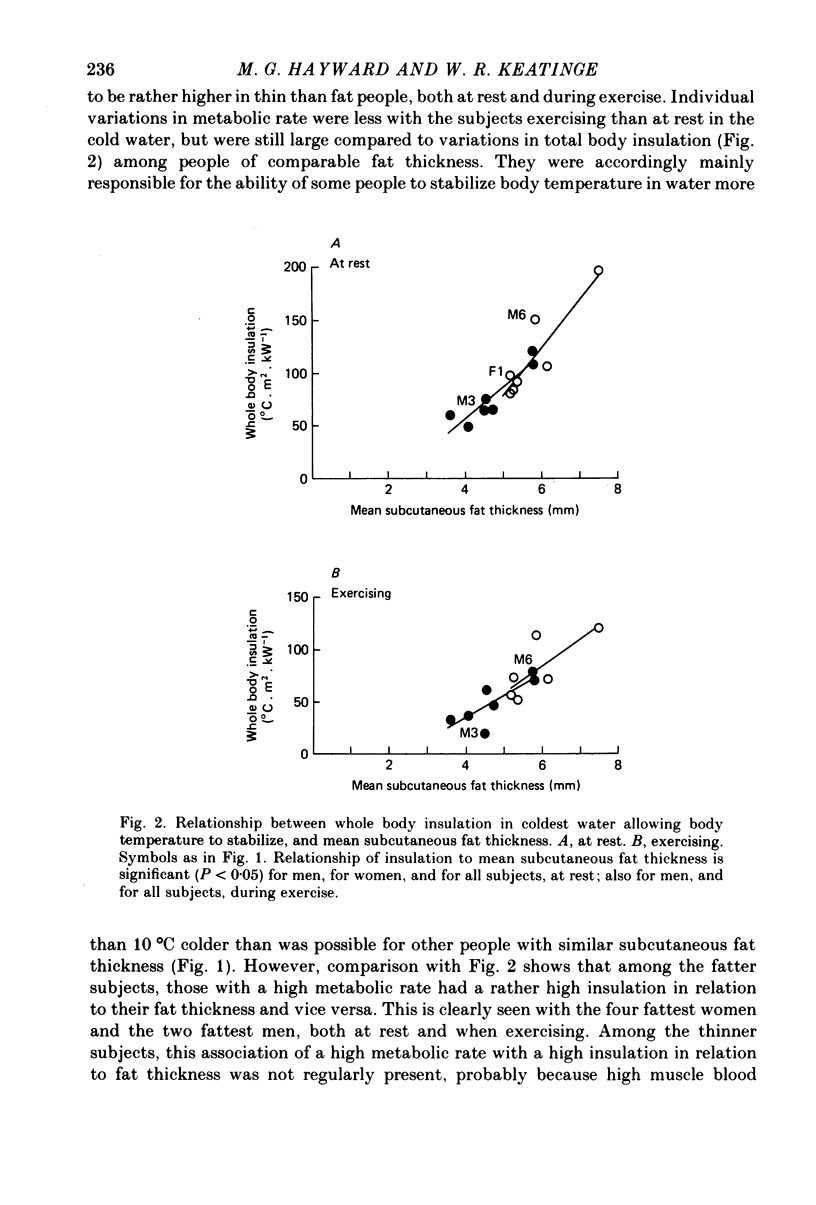
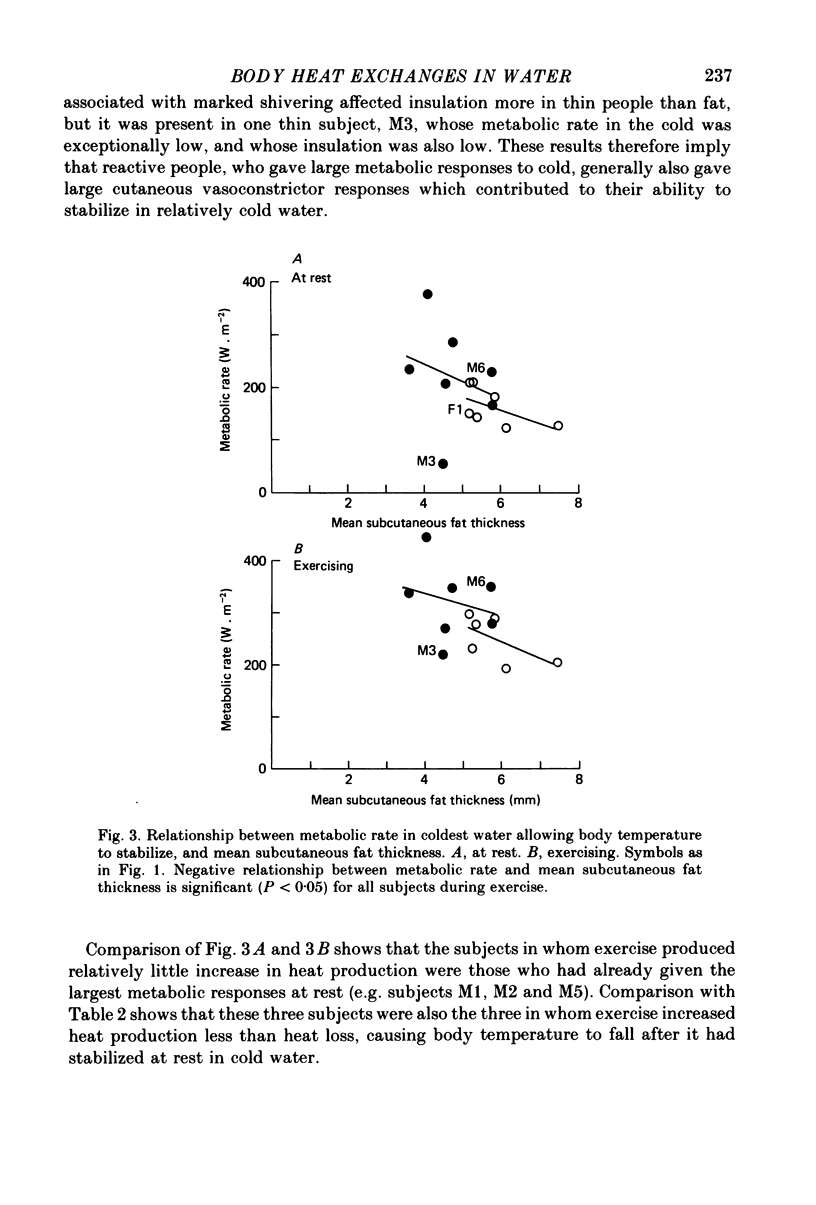
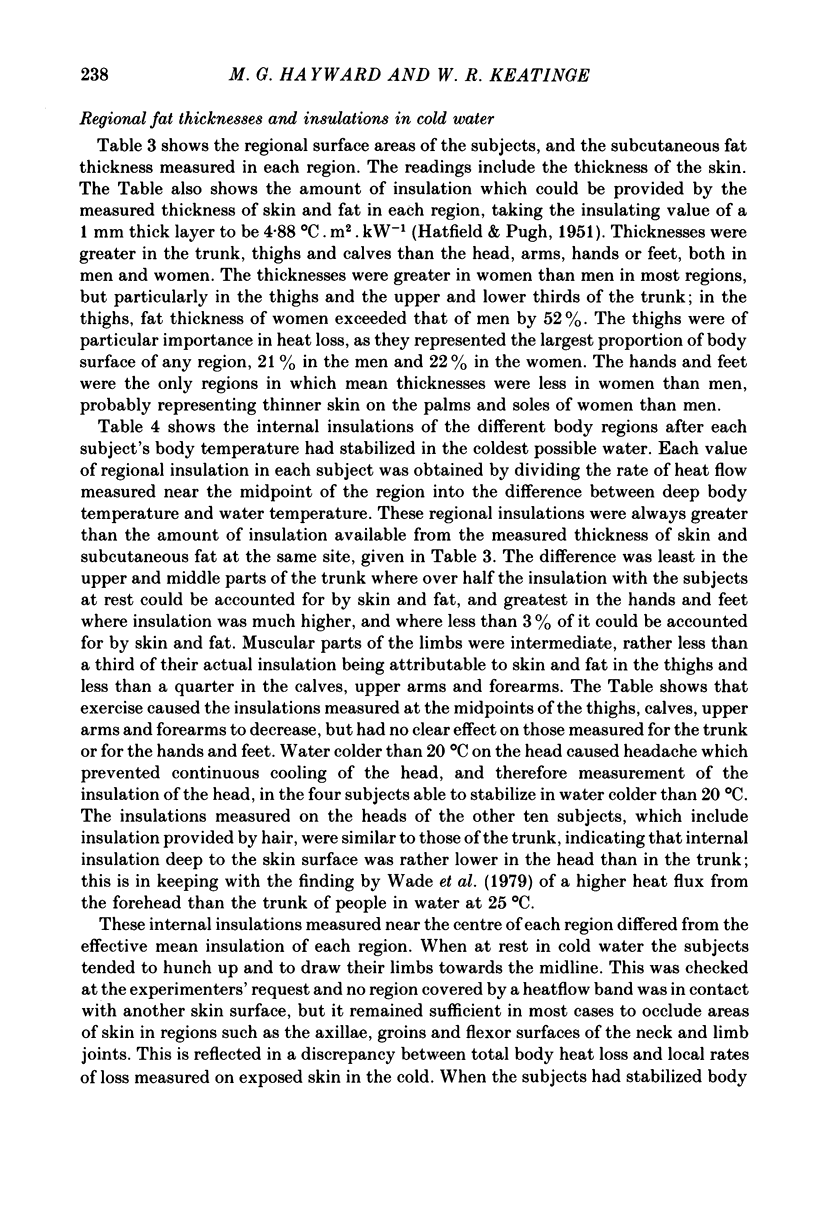
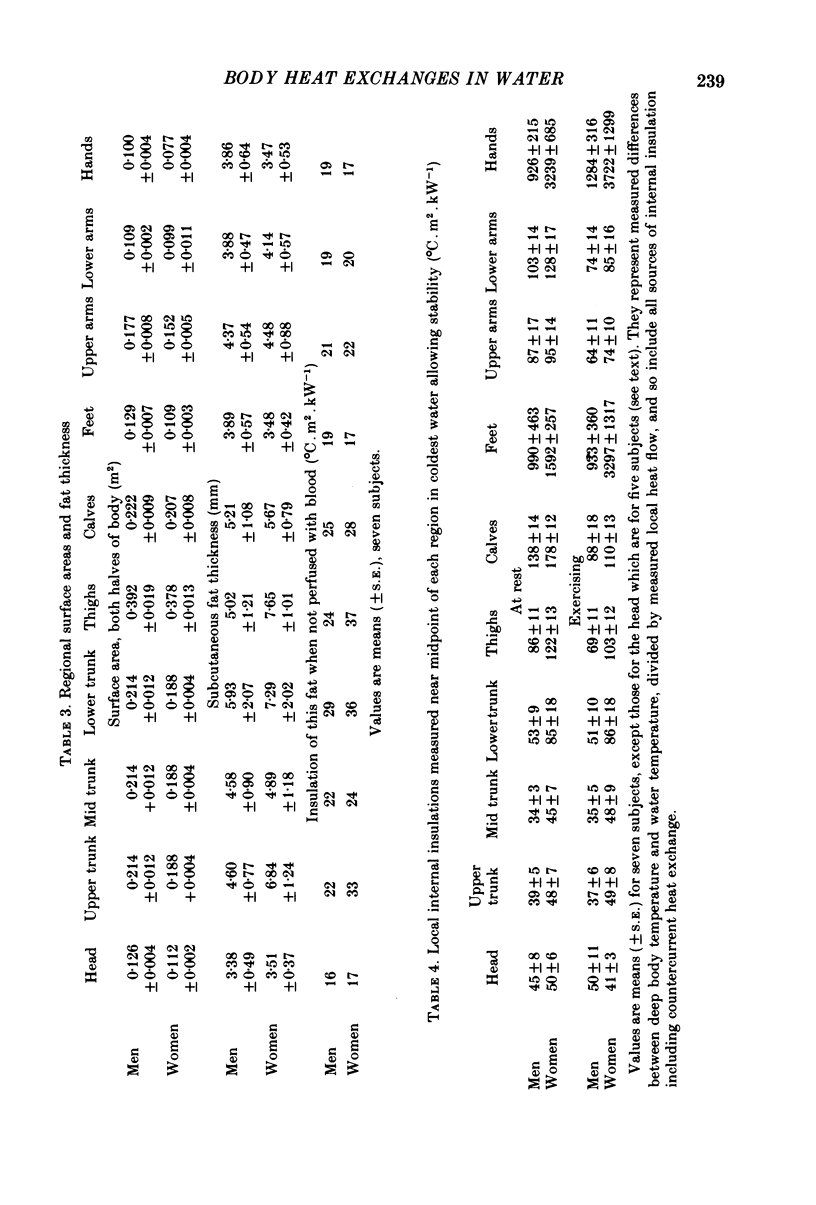
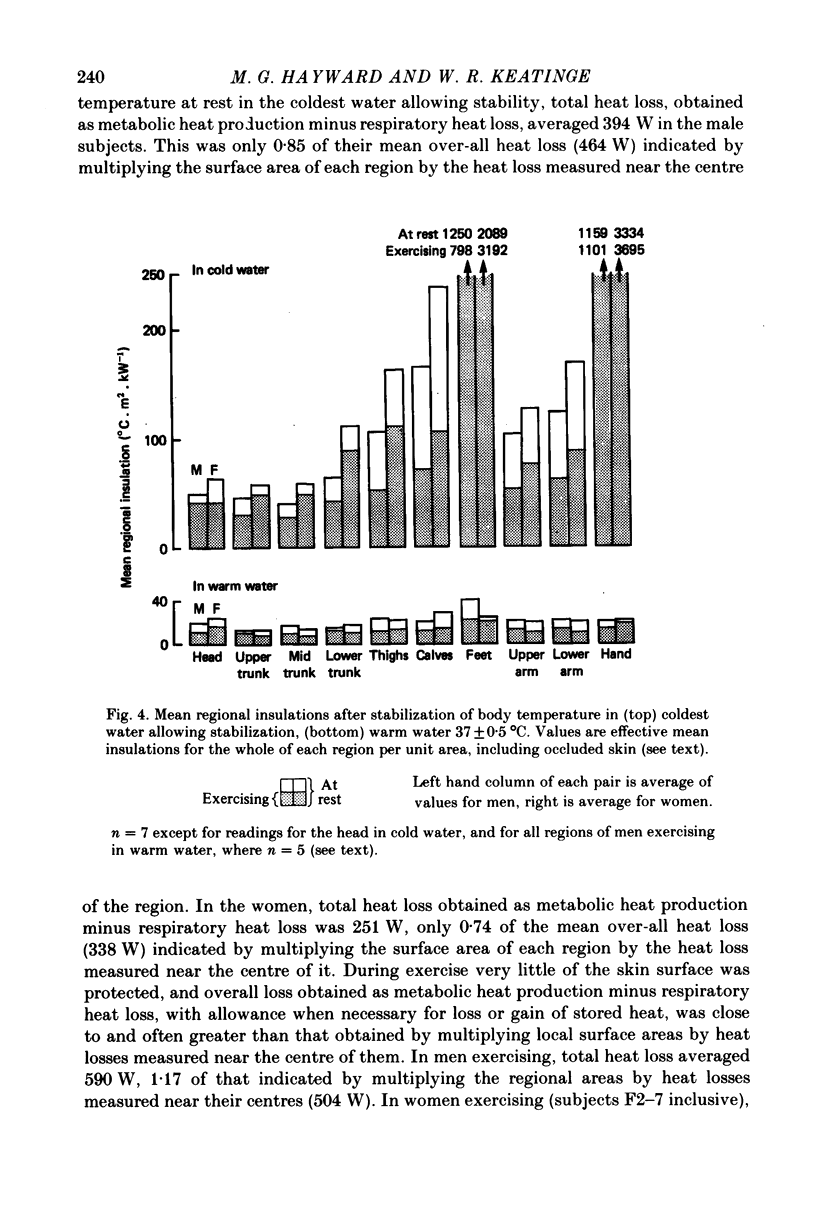
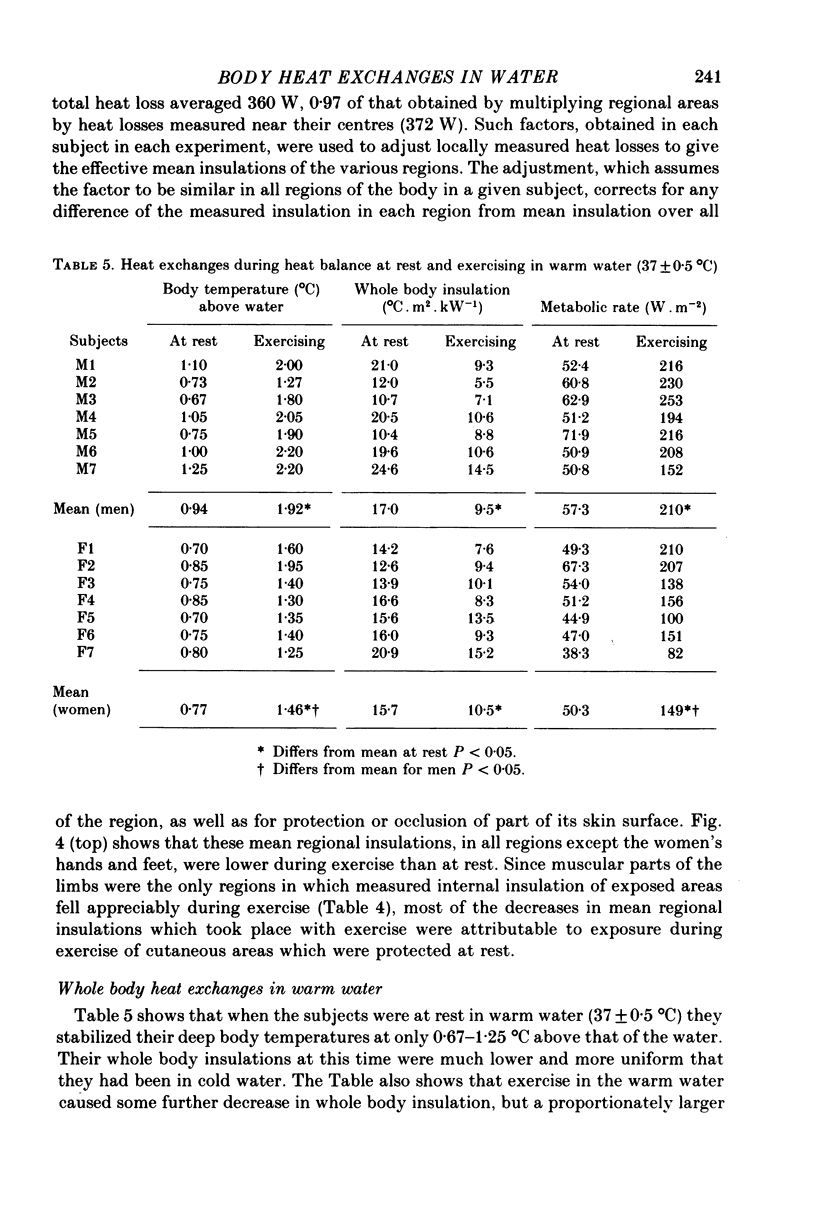
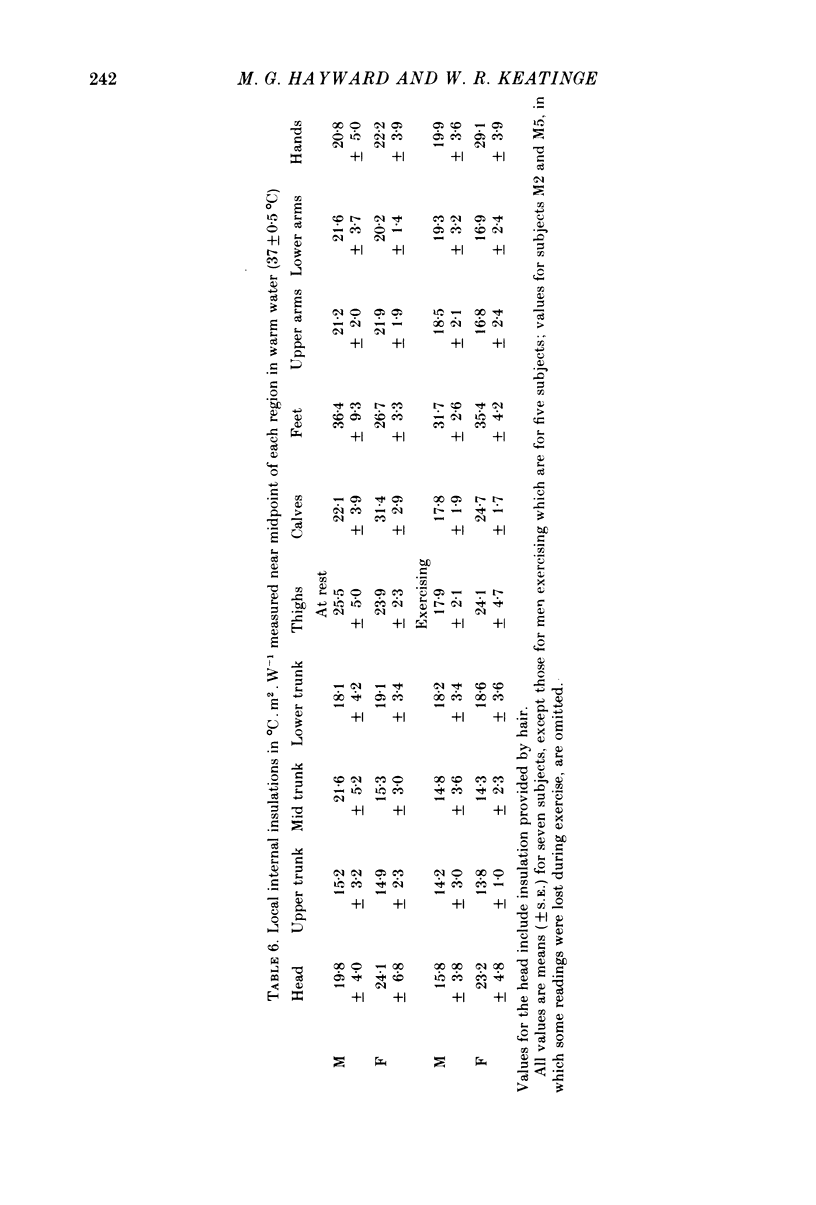
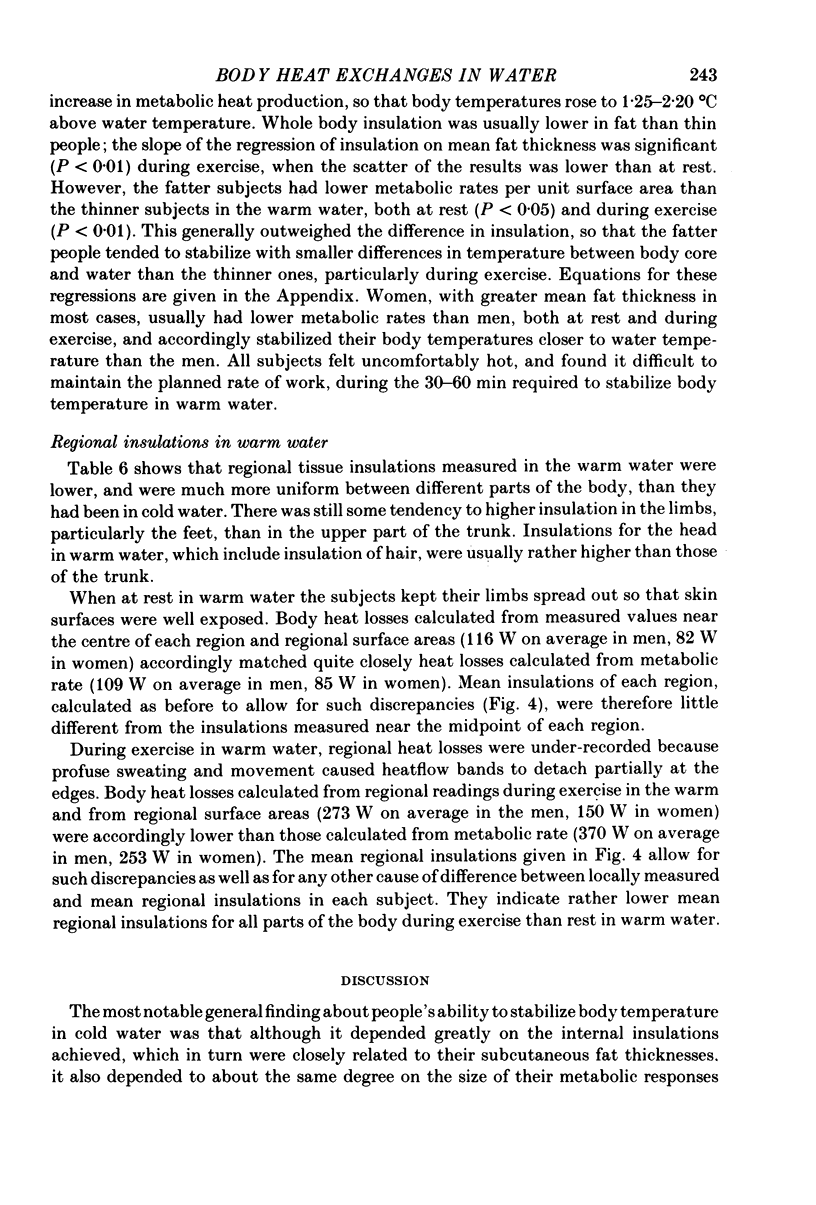
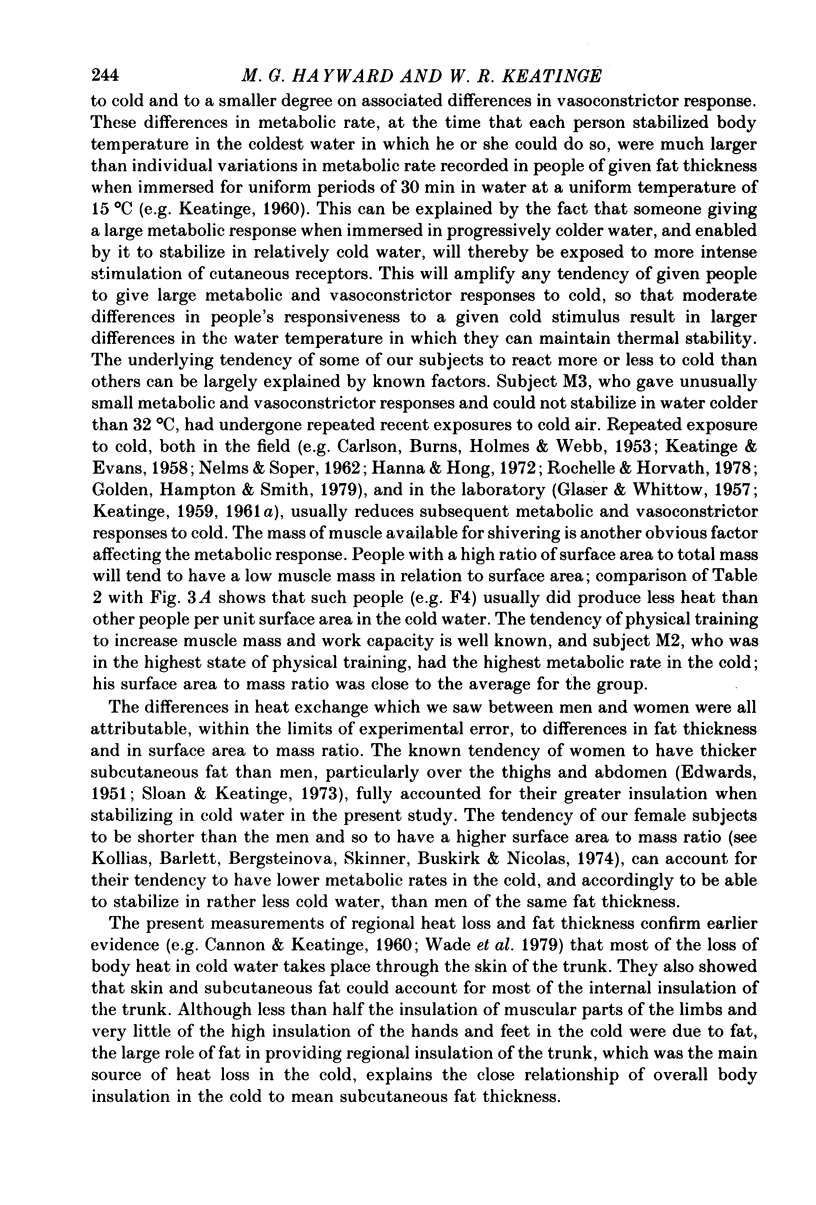
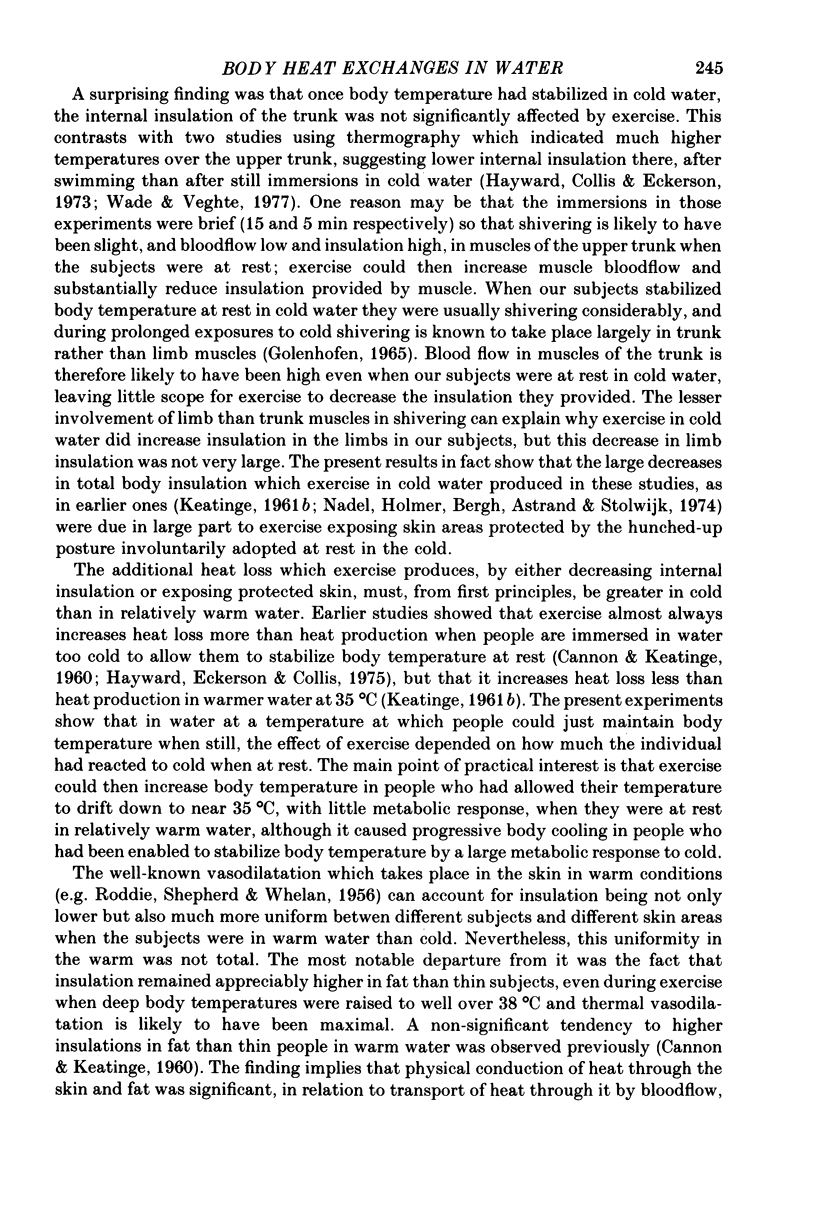
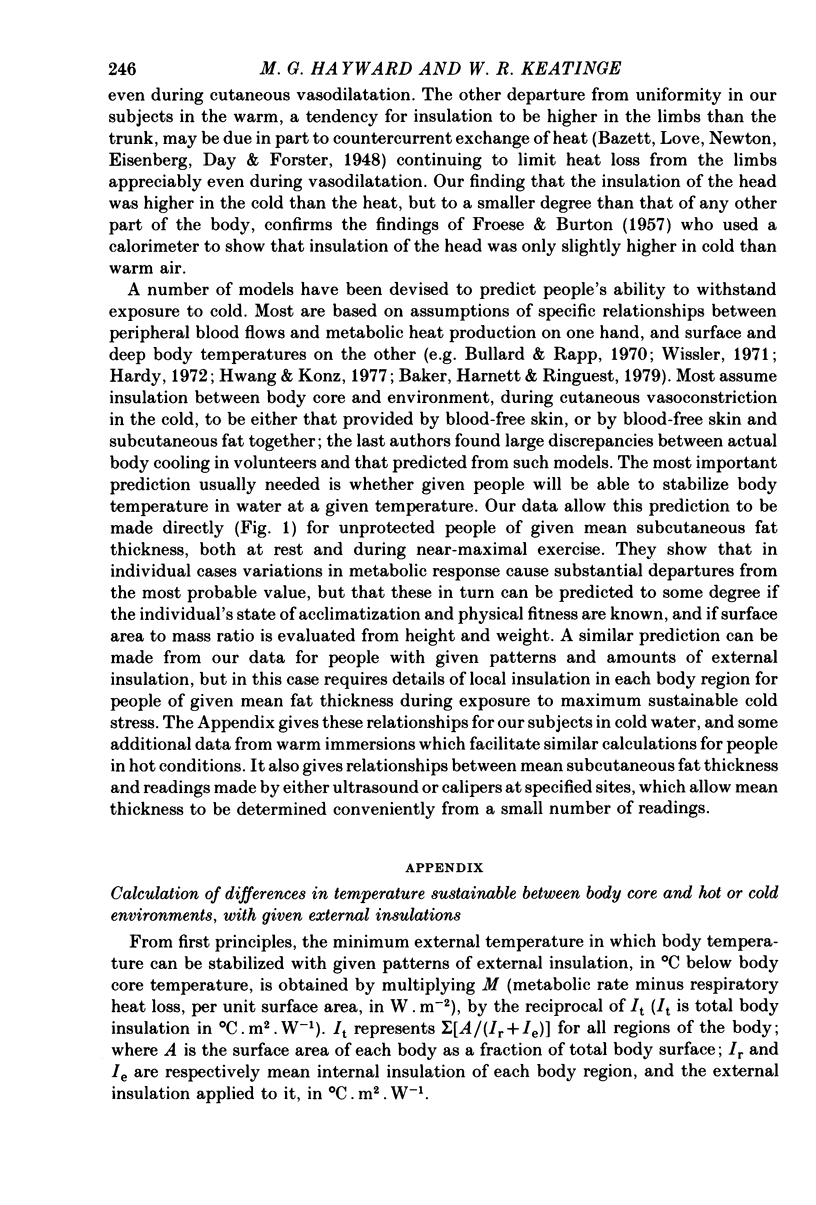
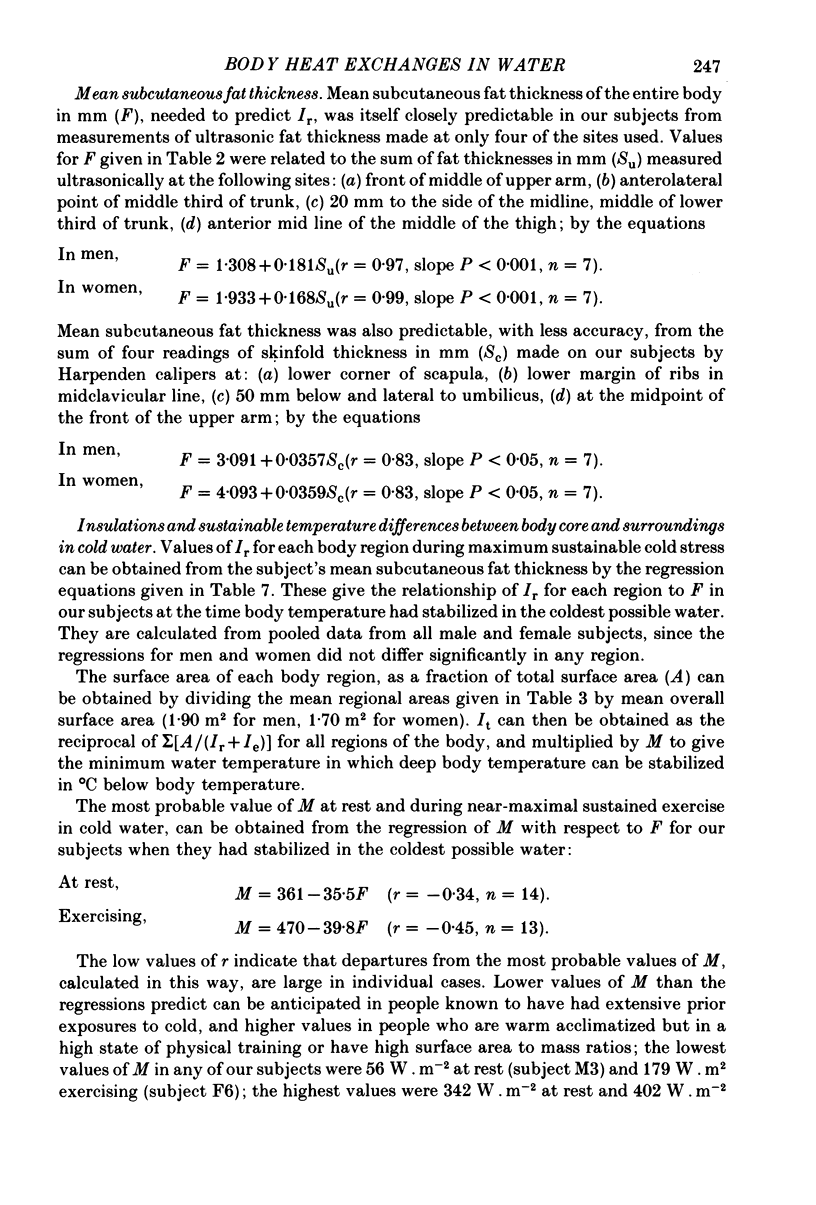
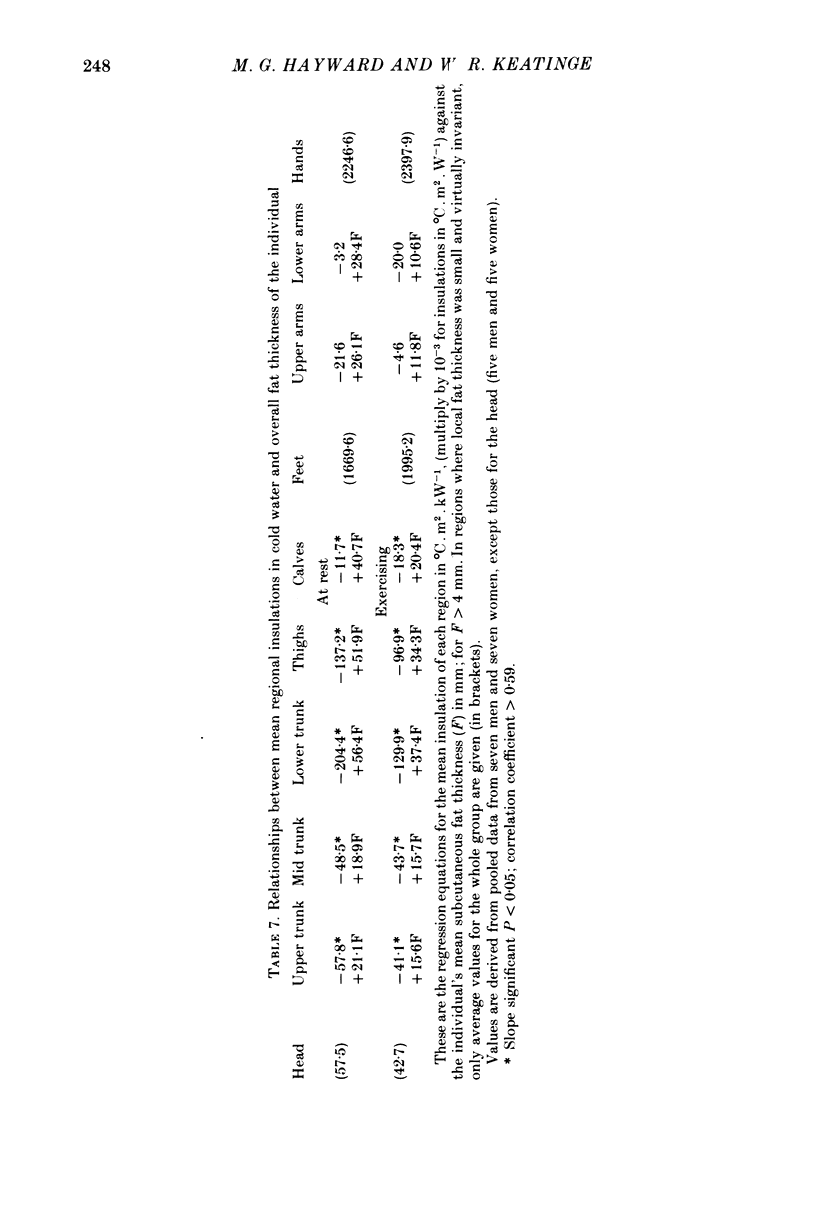
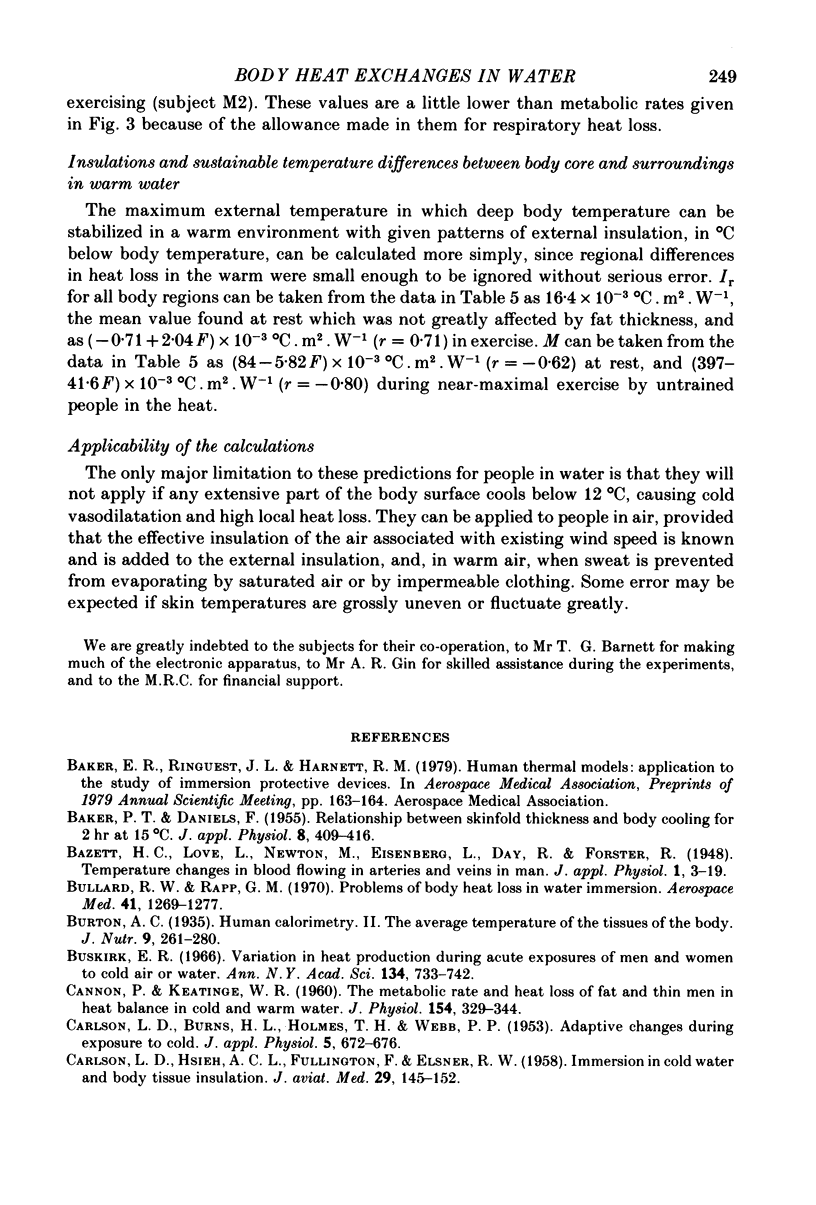
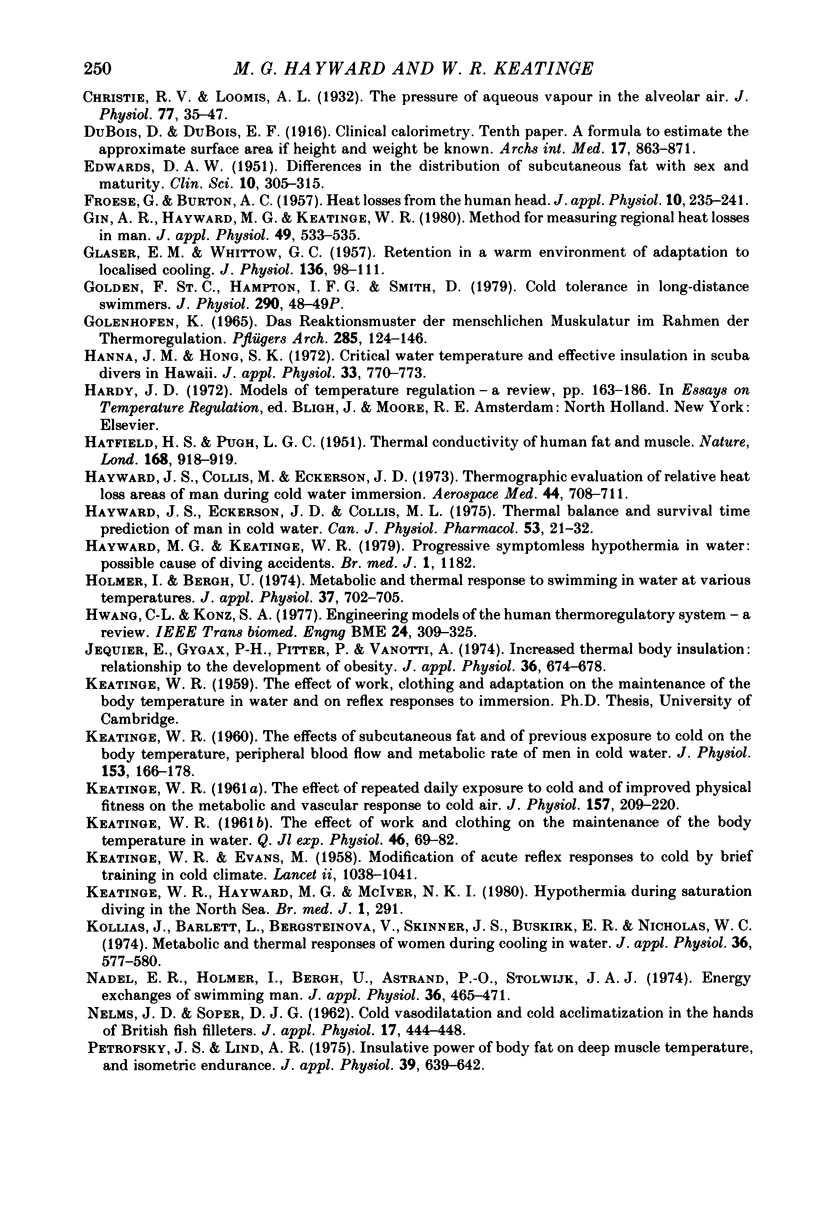
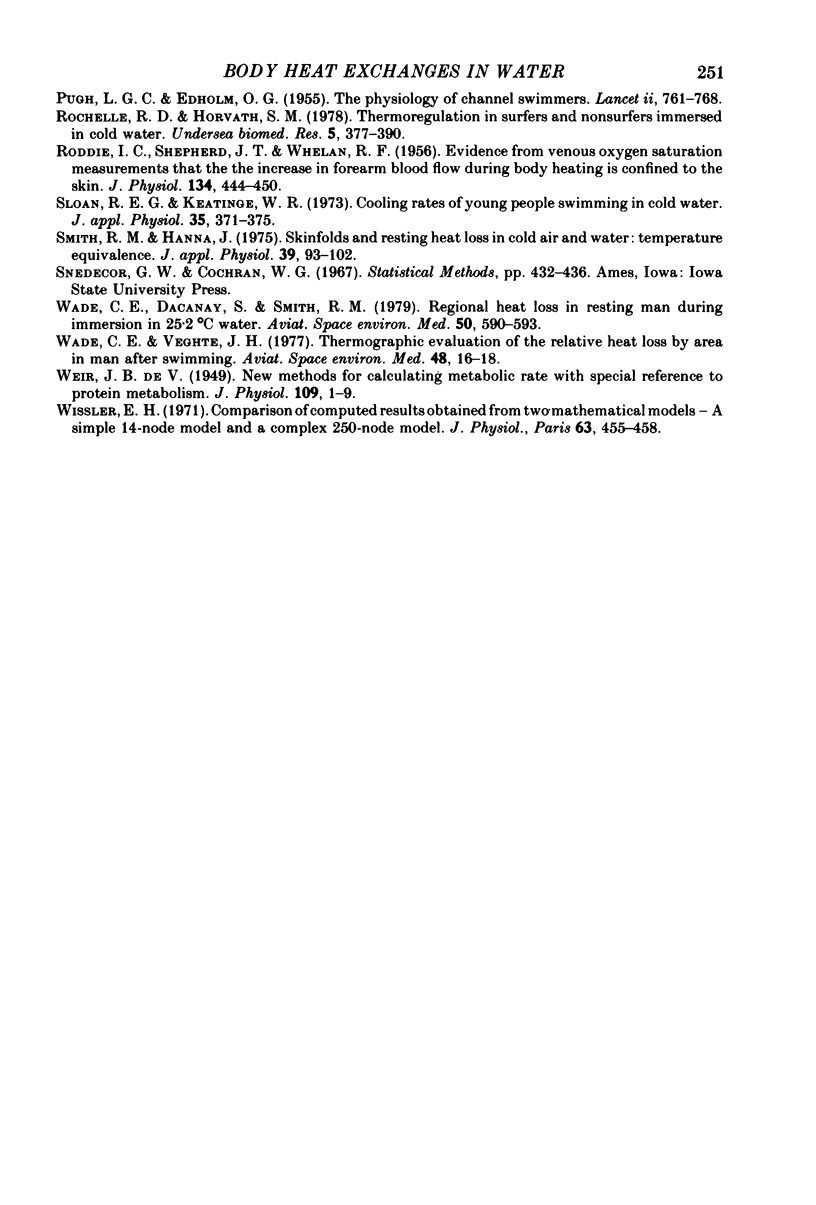
Selected References
These references are in PubMed. This may not be the complete list of references from this article.
- BAKER P. T., DANIELS F., Jr Relationship between skinfold thickness and body cooling for two hours at 15 degrees C. J Appl Physiol. 1956 Jan;8(4):409–416. doi: 10.1152/jappl.1956.8.4.409. [DOI] [PubMed] [Google Scholar]
- Bullard R. W., Rapp G. M. Problems of body heat loss in water immersion. Aerosp Med. 1970 Nov;41(11):1269–1277. [PubMed] [Google Scholar]
- CANNON P., KEATINGE W. R. The metabolic rate and heat loss of fat and thin men in heat balance in cold and warm water. J Physiol. 1960 Dec;154:329–344. doi: 10.1113/jphysiol.1960.sp006582. [DOI] [PMC free article] [PubMed] [Google Scholar]
- CARLSON L. D., BURNS H. L., HOLMES T. H., WEBB P. P. Adaptive changes during exposure to cold. J Appl Physiol. 1953 May;5(11):672–676. doi: 10.1152/jappl.1953.5.11.672. [DOI] [PubMed] [Google Scholar]
- CARLSON L. D., HSIEH A. C., FULLINGTON F., ELSNER R. W. Immersion in cold water and body tissue insulation. J Aviat Med. 1958 Feb;29(2):145–152. [PubMed] [Google Scholar]
- Christie R. V., Loomis A. L. The pressure of aqueous vapour in the alveolar air. J Physiol. 1932 Dec 19;77(1):35–48. doi: 10.1113/jphysiol.1932.sp002948. [DOI] [PMC free article] [PubMed] [Google Scholar]
- EDWARDS D. A. W. Differences in the distribution of subcutaneous fat with sex and maturity. Clin Sci. 1951 Aug;10(3):305–315. [PubMed] [Google Scholar]
- FROESE G., BURTON A. C. Heat losses from the human head. J Appl Physiol. 1957 Mar;10(2):235–241. doi: 10.1152/jappl.1957.10.2.235. [DOI] [PubMed] [Google Scholar]
- GLASER E. M., WHITTOW G. C. Retention in a warm environment of adaptation to localized cooling. J Physiol. 1957 Apr 3;136(1):98–111. doi: 10.1113/jphysiol.1957.sp005745. [DOI] [PMC free article] [PubMed] [Google Scholar]
- Gin A. R., Hayward M. G., Keatinge W. R. Method for measuring regional heat losses in man. J Appl Physiol Respir Environ Exerc Physiol. 1980 Sep;49(3):533–535. doi: 10.1152/jappl.1980.49.3.533. [DOI] [PubMed] [Google Scholar]
- Golden F. S., Hampton I. F., Smith D. Cold tolerance in long-distance swimmers [proceedings]. J Physiol. 1979 May;290(2):48P–49P. [PubMed] [Google Scholar]
- Golenhofen K. Das Reaktionsmuster der menschlichen Muskulatur im Rahmen der Thermoregulation. Pflugers Arch Gesamte Physiol Menschen Tiere. 1965 Aug 6;285(2):124–146. [PubMed] [Google Scholar]
- HATFIELD H. S., PUCH L. G. C. Thermal conductivity of human fat and muscle. Nature. 1951 Nov 24;168(4282):918–919. doi: 10.1038/168918a0. [DOI] [PubMed] [Google Scholar]
- Hanna J. M., Hong S. K. Critical water temperature and effective insulation in scuba divers in Hawaii. J Appl Physiol. 1972 Dec;33(6):770–773. doi: 10.1152/jappl.1972.33.6.770. [DOI] [PubMed] [Google Scholar]
- Hayward J. S., Collis M., Eckerson J. D. Thermographic evaluation of relative heat loss areas of man during cold water immersion. Aerosp Med. 1973 Jul;44(7):708–711. [PubMed] [Google Scholar]
- Hayward J. S., Eckerson J. D., Collis M. L. Thermal balance and survival time prediction of man in cold water. Can J Physiol Pharmacol. 1975 Feb;53(1):21–32. doi: 10.1139/y75-002. [DOI] [PubMed] [Google Scholar]
- Hayward M. G., Keatinge W. R. Progressive symptomless hypothermia in water: possible cause of diving accidents. Br Med J. 1979 May 5;1(6172):1182–1182. doi: 10.1136/bmj.1.6172.1182. [DOI] [PMC free article] [PubMed] [Google Scholar]
- Holmér I., Bergh U. Metabolic and thermal response to swimming in water at varying temperatures. J Appl Physiol. 1974 Nov;37(5):702–705. doi: 10.1152/jappl.1974.37.5.702. [DOI] [PubMed] [Google Scholar]
- Hwang C. L., Konz S. A. Engineering models of the human thermoregulatory system--a review. IEEE Trans Biomed Eng. 1977 Jul;24(4):309–325. doi: 10.1109/TBME.1977.326137. [DOI] [PubMed] [Google Scholar]
- Jéquier E., Gygax P. H., Pittet P., Vannotti A. Increased thermal body insulation: relationship to the development of obesity. J Appl Physiol. 1974 Jun;36(6):674–678. doi: 10.1152/jappl.1974.36.6.674. [DOI] [PubMed] [Google Scholar]
- KEATINGE W. R., EVANS M. Modification of acute reflex responses to cold by brief training in cold climate. Lancet. 1958 Nov 15;2(7055):1038–1041. doi: 10.1016/s0140-6736(58)90533-6. [DOI] [PubMed] [Google Scholar]
- KEATINGE W. R. The effect of repeated daily exposure to cold and of improved physical fitness on the metabolic and vascular response to cold air. J Physiol. 1961 Jul;157:209–220. doi: 10.1113/jphysiol.1961.sp006716. [DOI] [PMC free article] [PubMed] [Google Scholar]
- KEATINGE W. R. The effect of work and clothing on the maintenance of the body temperature in water. Q J Exp Physiol Cogn Med Sci. 1961 Jan;46:69–82. doi: 10.1113/expphysiol.1961.sp001517. [DOI] [PubMed] [Google Scholar]
- KEATINGE W. R. The effects of subcutaneous fat and of previous exposure to cold on the body temperature, peripheral blood flow and metabolic rate of men in cold water. J Physiol. 1960 Aug;153:166–178. doi: 10.1113/jphysiol.1960.sp006526. [DOI] [PMC free article] [PubMed] [Google Scholar]
- Keatinge W. R., Hayward M. G., McIver N. K. Hypothermia during saturation diving in the North Sea. Br Med J. 1980 Feb 2;280(6210):291–291. doi: 10.1136/bmj.280.6210.291. [DOI] [PMC free article] [PubMed] [Google Scholar]
- NELMS J. D., SOPER D. J. Cold vasodilatation and cold acclimatization in the hands of British fish filleters. J Appl Physiol. 1962 May;17:444–448. doi: 10.1152/jappl.1962.17.3.444. [DOI] [PubMed] [Google Scholar]
- Nadel E. R., Holmér I., Bergh U., Astrand P. O., Stolwijk J. A. Energy exchanges of swimming man. J Appl Physiol. 1974 Apr;36(4):465–471. doi: 10.1152/jappl.1974.36.4.465. [DOI] [PubMed] [Google Scholar]
- PUGH L. G., EDHOLM O. G. The physiology of channel swimmers. Lancet. 1955 Oct 8;269(6893):761–768. doi: 10.1016/s0140-6736(55)92454-5. [DOI] [PubMed] [Google Scholar]
- Petrofsky J. S., Lind A. R. Insulative power of body fat on deep muscle temperatures and isometric endurance. J Appl Physiol. 1975 Oct;39(4):639–642. doi: 10.1152/jappl.1975.39.4.639. [DOI] [PubMed] [Google Scholar]
- RODDIE I. C., SHEPHERD J. T., WHELAN R. F. Evidence from venous oxygen saturation measurements that the increase in forearm blood flow during body heating is confined to the skin. J Physiol. 1956 Nov 28;134(2):444–450. doi: 10.1113/jphysiol.1956.sp005656. [DOI] [PMC free article] [PubMed] [Google Scholar]
- Rochelle R. D., Horvath S. M. Thermoregulation in surfers and nonsurfers immersed in cold water. Undersea Biomed Res. 1978 Dec;5(4):377–390. [PubMed] [Google Scholar]
- Sloan R. E., Keatinge W. R. Cooling rates of young people swimming in cold water. J Appl Physiol. 1973 Sep;35(3):371–375. doi: 10.1152/jappl.1973.35.3.371. [DOI] [PubMed] [Google Scholar]
- Smith R. M., Hanna J. M. Skinfolds and resting heat loss in cold air and water: temperature equivalence. J Appl Physiol. 1975 Jul;39(1):93–102. doi: 10.1152/jappl.1975.39.1.93. [DOI] [PubMed] [Google Scholar]
- WEIR J. B. DE B. New methods for calculating metabolic rate with special reference to protein metabolism. J Physiol. 1949 Aug;109(1-2):1–9. doi: 10.1113/jphysiol.1949.sp004363. [DOI] [PMC free article] [PubMed] [Google Scholar]
- Wade C. E., Dacanay S., Smith R. M. Regional heat loss in resting man during immersion in 25.2 degrees C water. Aviat Space Environ Med. 1979 Jun;50(6):590–593. [PubMed] [Google Scholar]
- Wade C. E., Veghte J. H. Thermographic evaluation of the relative heat loss by area in man after swimming. Aviat Space Environ Med. 1977 Jan;48(1):16–18. [PubMed] [Google Scholar]
- Wissler E. H. Comparison of computed results obtained from two mathematical models: a simple 14-node model and a complex 250-node model. J Physiol (Paris) 1971 May;63(3):455–458. [PubMed] [Google Scholar]


